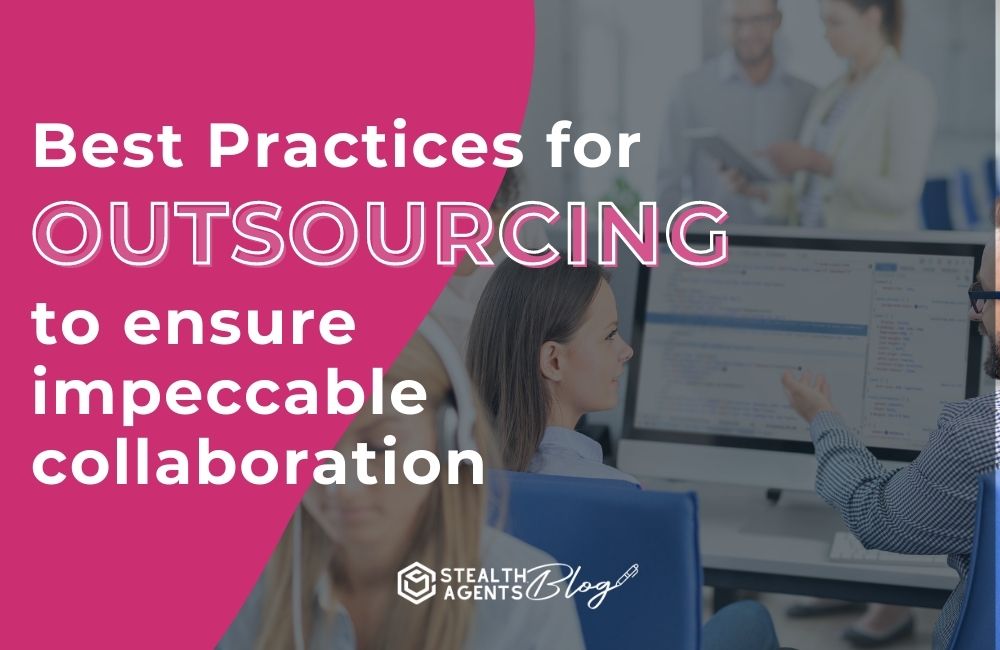Outsourcing best practices are essential for scaling efficiently, and Stealth Agents ensures every step from clear communication to expert matching, is handled with precision. With Stealth Agents, you get a reliable outsourcing partner that helps you save time, reduce risk, and achieve business goals faster.
Running a business gets expensive fast when sales are flat and leads are nowhere to be found. Poor processes, slow task delivery, and unclear delegation can quietly drain your profit. Best Practices For Outsourcing help you cut costs, reduce stress, and scale without hiring full-time staff you can’t afford.
Studies show that nearly 50% of small businesses fail within five years, most due to poor resource management. This is where smart outsourcing can change everything, and Stealth Agents gives you access to vetted professionals ready to handle what slows you down. By listing your business, you boost your visibility, build trust, and tap into a growing B2B network that’s built to help you grow. Register now to list your business and connect with other Virtual Assistants through Stealth Agents, and start working smarter today.
What should be included in an outsourcing contract?
An outsourcing contract should include clauses on the scope of work, timelines, payment terms, confidentiality agreements, intellectual property rights, performance metrics, and provisions for flexibility in case of changing requirements.
How can I maintain control over my project when outsourcing?
Maintain control over your project by setting clear goals and deliverables, being actively involved in critical phases, using project management tools, and conducting regular progress reviews to ensure alignment with your objectives.
Outsourcing Best Practices
1. Define Clear Objectives and Scope
Before embarking on an outsourcing journey, having a well-defined objective and scope of work is imperative. This involves:
- Setting Specific Goals: Outline what you aim to achieve through outsourcing, whether it’s cost reduction, access to expertise, or freeing up internal resources.
- Detailing the Scope: Clearly articulate the tasks, deliverables, timelines, and performance expectations. Ambiguity in these areas can lead to misunderstandings and conflicts later.
2. Select the Right Outsourcing Partner
Choosing the right partner can make or break your outsourcing initiative. Evaluate potential partners based on:
- Expertise and Experience: Ensure the provider has a proven track record in the specific area you need. Ask for case studies or references to validate their capabilities.
- Cultural Fit: A good cultural alignment can facilitate smoother interactions and a more harmonious working relationship. Look for partners whose values and work ethics mirror yours.
- Financial Stability: Ensure the outsourcing provider is financially sound and capable of sustaining a long-term partnership.
3. Establish Strong Communication Channels
Effective communication is the cornerstone of a successful outsourcing partnership. Implement the following measures:
- Regular Updates and Meetings:Schedule consistent check-ins to discuss progress, challenges, and feedback. Stay connected using communication tools like video conferencing, project management software, and instant messaging platforms.
- Clear Points of Contact: Designate individuals responsible for communication on both sides. This ensures accountability and streamlines the information.
4. Create Comprehensive Contracts
A well-drafted contract protects both parties and sets clear expectations. Include:
- Scope and Deliverables: Precisely define the work and deliverables the outsourcing partner expects.
- Performance Metrics: Establish Key Performance Indicators (KPIs) to measure the provider’s Performance. Objectivity and Data Security: Protect your data and intellectual property rights to safeguard your business interests.
- Dispute Resolution: Outline procedures for resolving disagreements to avoid prolonged conflicts.
5. Foster Trust and Mutual Respect
Building trust is essential for any collaborative effort. Encourage:
- Transparency: Be open about your business goals, challenges, and expectations. Encourage your outsourcing partner to do the same.
- Respect: Value your outsourcing partner’s expertise and input. Recognize their contributions and foster a collaborative rather than transactional relationship.
6. Monitor and Measure Performance
RegPerformance: Tracking the partner’s Performance ensures that work is on track and aligns with your standards. Utilize the following strategies:
- KPIs and Milestones: Continuously track KPIs and milestones established in your contract.
- Feedback Loops: Establish a loop in the system that provides constructive feedback and addresses issues. Performance reviews should be a staple in your collaboration routine.
- Quality Assurance: Implement robust quality control measures to ensure the quality of output.
7. Promote Continuous Improvement
Encourage a culture of continuous improvement by:
- Feedback and Learning: Regularly exchange input and use it as a learning tool for both parties.
- Innovation Encouragement: Motivate your outsourcing partner to innovate and suggest improvements that benefit the project.
8. Ensure Flexibility and Scalability
Business needs often evolve, and your outsourcing partnership should be flexible enough to adapt. Ensure:
- Contract Flexibility: Draft contracts with flexibility clauses that allow amendments based on changing requirements.
- Scalability: Select a partner capable of scaling operations up or down per your needs. This adaptability will enable your business to manage changing demands without significant disruptions.
9. Leverage Technology
UtiliTechnology processes and fosters collaboration:
- Project management tools, such as Asana, Trello, and Jira, can help manage tasks, track progress, and ensure everyone is aligned.
- Communication platforms use platforms like Slack, Microsoft Teams, or Zoom for seamless and instant communication.
- Document Sharing: For efficient document sharing and version control, use cloud-based solutions like Google Drive, Dropbox, or SharePoint.
10. Cultural Sensitivity and Inclusiveness
Acknowledge and respect cultural differences to forge a strong working relationship. Achieve this by:
- Cultural Training: Provide cultural sensitivity training to your team to improve interactions and understanding.
- Inclusiveness in Decision-Making: Involve your outsourcing partner in decision-making processes that affect the project
Best Practices for Outsourcing: What tasks should I outsource first?
When you’re just starting with outsourcing, the best practices for outsourcing recommend focusing on repetitive, time-consuming tasks that don’t require your direct attention every day. One of the smartest outsourcing examples includes administrative work like inbox management, calendar scheduling, and data entry these are perfect for a best medical claims virtual assistant or an executive assistant in Arizona.
You can also begin by delegating customer service and medical transcription outsourcing, which are simple yet critical to daily operations. Choosing a service that can handle these tasks remotely helps free your team to focus on sales and growth.
According to outsourcing tips from business experts, delegating non-core tasks is part of the best practices for outsourcing project work, saving time and money quickly. If you’re still unsure where to begin, an outsourcing guideline is to ask, “What’s slowing my business down that someone else can do just as well?” That’s the task you outsource first.
Best Practices for Outsourcing: How do I choose the right outsourcing partner?
Picking the right partner is one of the most important best practices for outsourcing, and it starts by clearly knowing what you need help with and the results you expect. A good outsourcing company Philippines will have real experience with similar businesses and offer a service that can grow with your company without making things more complicated. Make sure they follow proven outsourcing guidelines and provide transparency, quality control, and strong communication.
Look for companies with real client success stories and trust signals like “top reviewed” or “recognized service provider.” For example, if you need help with medical transcription outsourcing or an executive assistant in Arizona, make sure your partner has that specific talent ready. It also helps to review outsourcing tips like checking tools, pricing clarity, and local vs. offshore options. The best partner doesn’t just work for you they work with you.
Best Practices for Outsourcing: Why do growing companies outsource instead of hiring?
Growing companies often turn to outsourcing project work because hiring full-time staff takes too much time, money, and long-term commitment, especially for tasks outside their core focus. By choosing a service that can take over admin work, support, or industry-specific tasks like medical transcription outsourcing, businesses stay lean while still getting everything done. The best practices for outsourcing focus on flexibility and cost control companies only pay for what they need when they need it.
This is a smart choice when workloads change often or when teams need quick support without going through long hiring cycles. Many also choose outsourcing because they want fast access to experts, such as the best medical claims virtual assistant or a reliable executive assistant that Arizona businesses already use. As part of standard outsourcing examples, many even outsource customer care, payroll, and backend work. Outsourcing lets companies stay focused on growth, not paperwork.
Takeaways
When done right, outsourcing can be a powerful strategy to propel business growth and innovation. By following these best practices, businesses can ensure a collaborative, productive, and harmonious relationship with their outsourcing partners. Clear objectives, effective communication, strong contracts, and mutual respect are fundamental to such relationships.
Frequently Asked Questions
What are the biggest outsourcing mistakes to avoid in 2025?
Mistakes include rushing to hire without checking the provider properly, not setting clear goals or performance measures, picking the cheapest option without considering quality, ignoring data security, and not having backup plans for problems. Also, avoid micromanaging the team and skipping efforts to build a good working relationship.
How much does outsourcing typically cost compared to hiring full-time employees?
Outsourcing usually costs 40-60% less than hiring full-time staff. This is because you save on salaries, benefits, office space, equipment, and training. For example, virtual assistants from services like Stealth Agents cost around $15/hour, giving businesses access to skilled workers without the extra expenses of traditional hiring.
Which industries benefit most from outsourcing best practices in 2025?
Industries like healthcare, real estate, insurance, solar, roofing, SaaS, fintech, e-commerce, and professional services benefit the most. These industries often have repetitive tasks, seasonal work spikes, or need special skills, making outsourcing a great way to handle work efficiently.
What security measures should be implemented when outsourcing business processes?
Use strong data encryption, secure VPNs, multi-factor authentication, and regular security checks. Make sure your outsourcing partner signs NDAs, has ISO certifications, checks their staff’s backgrounds, and uses secure file-sharing tools. Regular training and clear rules for handling data are also important to keep your information safe.
How long does it take to see ROI from outsourcing initiatives?
Most businesses see results within 30-90 days, with bigger returns in 3-6 months. How fast you see ROI depends on how complex the tasks are, how quickly the team gets started, and how well your processes are set up. Services with pre-vetted workers, like Stealth Agents, often deliver faster results.
What time zone considerations are important for outsourcing success?
Think about how much overlap you need for real-time communication. Some companies prefer different time zones for 24/7 work, while others need the same time zone for quick responses. Set clear rules for response times, use tools to manage projects, and plan handoffs carefully to keep things running smoothly.
How do you measure the success of outsourcing partnerships beyond cost savings?
Look at task accuracy, meeting deadlines, customer satisfaction, and how much productivity improves. Check how well the team communicates, how quickly they solve problems, and how they handle busy times. Also, see if outsourcing reduces stress for your in-house team and lets them focus on important work.
What technology integration challenges arise when implementing outsourcing?
Challenges include making sure software works together, setting up access permissions, syncing data, and training the team on your systems. Make sure your partner can work with your CRM, project tools, and communication platforms. Plan for possible delays during setup and have backup communication methods ready.
How do you handle quality control when outsourcing critical business functions?
Create clear step-by-step instructions (SOPs), do regular quality checks, and set up feedback systems to improve over time. Use dashboards to monitor progress, check work samples, and keep communication open. Some services, like Stealth Agents, have managers who oversee quality and regularly review performance.
What are the key legal considerations when outsourcing internationally?
Key points include following data protection laws (like GDPR or CCPA), protecting intellectual property, deciding which country’s laws apply, handling taxes, and understanding different employment rules. Contracts should include ways to resolve disputes, liability rules, and how to end the agreement. Work with providers who know international business laws to avoid problems.









